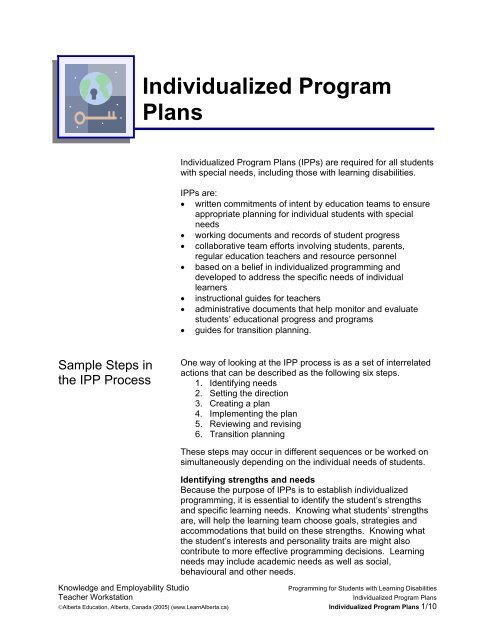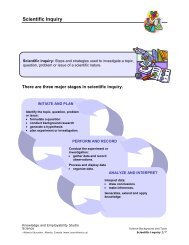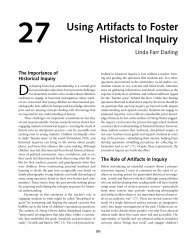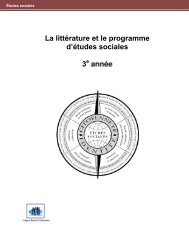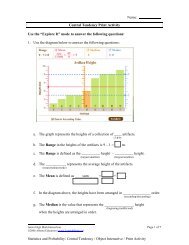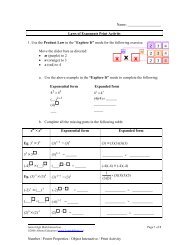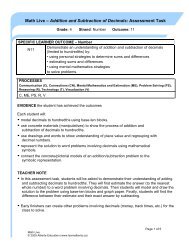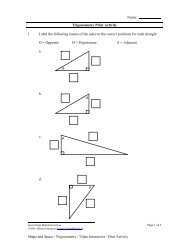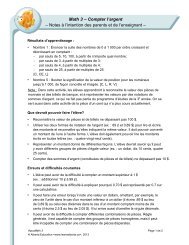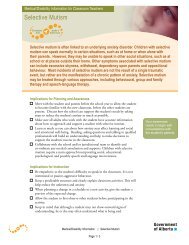Individualized Program Plans - LearnAlberta.ca
Individualized Program Plans - LearnAlberta.ca
Individualized Program Plans - LearnAlberta.ca
Create successful ePaper yourself
Turn your PDF publications into a flip-book with our unique Google optimized e-Paper software.
Specific accommodations for supporting the student also needto be identified at this stage of the process.Implementing the planIn this phase of the process, the learning team reviews thecontent of the IPP and how progress will be measured.Teachers then put the instructional and assessment strategiesinto practice, and adjust short-term objectives as needed.Parents and other team members may support the IPP goals athome or in other contexts.Reviewing and revisingOngoing review and revision are important parts of the IPPprocess. Review meetings are opportunities to discuss thestudent’s program and consider possible revisions. Theyear-end review is especially important as the team reviews theedu<strong>ca</strong>tion plan and adds written recommendations to the IPP.This is particularly true for students moving from one school toanother or making any kind of transition.Parents or other team members may also request a review ofthe IPP at any time if they have concerns about the student’sprogress or if the student is experiencing signifi<strong>ca</strong>nt changes inachievement, attitude or behaviour. The IPP <strong>ca</strong>n be adjusted orchanged at any time throughout the school year, as the teamdeems necessary.Transition planningTransition planning involves identifying the kinds of skills thatneed to be in place for students to be successful in futuresettings, and developing a plan of action to ensure studentsacquire these skills and attitudes. The annual transition planidentifies potential transitions within the next school year andoutlines strategies for preparing and supporting studentsthrough these transitions.Strategies toDevelop andImplement IPPsStudents with learning disabilities face complex challenges atthe junior high and senior high school levels. Students’ learningstrengths and needs interact with the evolving demands ofschooling that include increases in workload, the complexity ofcurriculum demands, the speed of presentation of material, thevolume of reading and writing, the abstractness of language andthe demands on memory. There may be larger classes andmany instructors with a wide range of expectations. Studentsare expected to be increasingly independent. Theorganizational structures and curriculum demands make it moredifficult to individualize programming, and social and emotionalfactors have a signifi<strong>ca</strong>nt impact.Knowledge and Employability StudioTeacher Workstation<strong>Program</strong>ming for Students with Learning Disabilities<strong>Individualized</strong> <strong>Program</strong> <strong>Plans</strong>©Alberta Edu<strong>ca</strong>tion, Alberta, Canada (2005) (www.<strong>LearnAlberta</strong>.<strong>ca</strong>) <strong>Individualized</strong> <strong>Program</strong> <strong>Plans</strong> 3/10
You <strong>ca</strong>n maximize the benefits of edu<strong>ca</strong>tional programming inthe junior high and senior high school years by emphasizing:– transition planning– meaningful parent involvement (with the gradual transfer ofresponsibility to students in senior high school)– self-advo<strong>ca</strong>cy– knowledge of learning strengths and needs– knowledge of effective accommodations– metacognitive skills: problem solving and higher orderprocessing, self-management– continued development of literacy skills– content-area instruction with appropriate accommodations,assessment and instructional strategies– instructional strategies to facilitate learning: explicit directinstruction, strategy instruction and strategic teaching are allimportant in junior high and senior high school.Specific strategies to facilitate the IPP process are outlinedbelow.Enhancing the collaborative team• Actively involve parents in the IPP process.– Seek parental input prior to IPP conferences; e.g., sendhome a form seeking information about parent goals,children’s preferences. See Goal Setting—Parent Formfor a sample template.– Discuss how and when parents want to be involved inand kept informed about their children’s edu<strong>ca</strong>tionprograms.– Assist parents in preparing for IPP meetings.– Create a draft IPP and invite meaningful input fromparents. Make changes and additions with their input.– Provide parents with a copy of the IPP to facilitate theirsupport at home and as a working copy for theirobservations.• Actively involve students in the IPP process with increasingparticipation and responsibility as students mature.– Involve adolescents in all aspects of planning andimplementing their instructional programs, includingassessment, program planning, goal setting, monitoring,evaluation and transition planning.– Involve students in selecting accommodations.Adolescents are sensitive to the reactions of their peersand prior discussion <strong>ca</strong>n help avoid embarrassment.– Provide coaching and opportunities for self-advo<strong>ca</strong>cy,such as approaching a content-area teacher to discussaccommodations.– Provide opportunities for students to try outaccommodations and evaluate their effectiveness.Knowledge and Employability StudioTeacher Workstation<strong>Program</strong>ming for Students with Learning Disabilities<strong>Individualized</strong> <strong>Program</strong> <strong>Plans</strong>©Alberta Edu<strong>ca</strong>tion, Alberta, Canada (2005) (www.<strong>LearnAlberta</strong>.<strong>ca</strong>) <strong>Individualized</strong> <strong>Program</strong> <strong>Plans</strong> 4/10
Knowledge and Employability StudioTeacher Workstation– Provide support in learning to use assistive technology,particularly computer technology. Keyboarding skillsand basic word processing skills are important tosuccess after senior high school.– Support students in taking responsibility for describingtheir needs and seeking appropriate support. For twostrategies you <strong>ca</strong>n share, seeHelping Students Communi<strong>ca</strong>te in the IPP Process.• Involve appropriate school personnel in developing IPPs.– All school personnel involved in providing instruction forstudents with learning disabilities should be involved indeveloping IPPs. Regular classroom teachers are betterable to use IPPs as instructional guides when they areinvolved in developing them.– IPPs are most effective when viewed in the context of anactive problem-solving process, which <strong>ca</strong>n be facilitatedby an organizational structure; e.g., Student SupportTeam Model, that provides a forum for ongoing teamplanning.– Provide professional development and guidance forteachers to increase understanding of the purpose andstructure of IPPs.– Encourage support for the IPP process; e.g., time forinvolvement, communi<strong>ca</strong>tion, access to additionalexpertise.Individualizing IPPs• Focus on the individual needs of students, not on the<strong>ca</strong>tegori<strong>ca</strong>l label. Avoid a generic list of accommodations:individuals with learning disabilities vary widely in theirstrengths and needs.• Consider ways that instruction <strong>ca</strong>n build on students’a<strong>ca</strong>demic, cognitive and processing strengths.• Consider the appropriate balance for individual students.Each student should participate in the regular curriculum asmuch as possible with accommodations to support success.Students may also need additional instruction to developskills and strategies.• Use multiple sources of assessment data to determinestrengths and needs.• Consider students’ needs beyond a<strong>ca</strong>demics, such as socialand behaviour needs.• Focus on key goals for the individual student.• Build in time for students to receive additionalinstruction/mentoring in literacy, learning and organizationalstrategies.• Consider the workload and students’ areas of difficulty.Where possible, adjust students’ timetables to balance thenumber of courses with heavy demands for reading andwritten assignments taken in a term.<strong>Program</strong>ming for Students with Learning Disabilities<strong>Individualized</strong> <strong>Program</strong> <strong>Plans</strong>©Alberta Edu<strong>ca</strong>tion, Alberta, Canada (2005) (www.<strong>LearnAlberta</strong>.<strong>ca</strong>) <strong>Individualized</strong> <strong>Program</strong> <strong>Plans</strong> 5/10
Knowledge and Employability StudioTeacher WorkstationUsing IPPs• IPPs need to be accessible working documents to be usefulfor ongoing instruction and monitoring. Some teachers keepthem in binders in their desks for planning lessons andnoting observations.• If there are several teachers responsible for a student’sedu<strong>ca</strong>tion program, it is important to develop procedures forall teachers to have access to the IPP so they <strong>ca</strong>n use it toplan instruction, monitor progress, and contribute toevaluating and changing goals and objectives.• Designate a key contact person on staff to whom a student<strong>ca</strong>n go for assistance, who monitors student progress andcoordinates the student’s program. Some students needdaily communi<strong>ca</strong>tion with a key contact person.Monitoring student progress• Use diverse assessment and evaluation strategies todemonstrate and communi<strong>ca</strong>te progress.• Monitor progress frequently. If objectives are met, set newones. If the student is not demonstrating progress, reviewthe program and make changes.– Gather baseline data as a benchmark for comparison todemonstrate growth.– Organize ongoing frequent monitoring of studentprogress in reading and writing; e.g., systematic weeklychecks, timed readings, observations during oralreading, daily journal writing and response, spellingtests.– Gather information about the effectiveness ofaccommodations. Does the student benefit from extratime on exams? Does the quality of the student’s writtenwork improve when produced on a computer?– Make decisions about the need for instructionalmodifi<strong>ca</strong>tions if the student is not progressing.• Use IPPs as working documents. Record, note or attachassessment information. Make changes and additions asrequired.• Use a variety of techniques and instruments to assess thefull range of student knowledge, skills and attitudes, andgather information about student learning. Assessment maybe curriculum-based or focused on IPP goals for thestudent. Plan and revise instruction based on thisinformation.• Consider the following assessment approaches.– Student portfolios– Rubrics– Error analysis– Informal reading inventories– Assessment of student responses, products orperformances<strong>Program</strong>ming for Students with Learning Disabilities<strong>Individualized</strong> <strong>Program</strong> <strong>Plans</strong>©Alberta Edu<strong>ca</strong>tion, Alberta, Canada (2005) (www.<strong>LearnAlberta</strong>.<strong>ca</strong>) <strong>Individualized</strong> <strong>Program</strong> <strong>Plans</strong> 6/10
– Observation– For more information on possible assessment strategies,see Assessment.Guiding transition planning– Make collaborative, comprehensive transition plans wellin advance of anticipated transitions.– Organize ongoing dynamic transition planningthroughout junior high and senior high school.– Organize transitions from junior high to senior highschool. The transfer of information about students isextremely important. Schedule transition planningmeetings well before the transition to senior high schoolto provide students, parents and school personnel withkey information to facilitate the continuity ofprogramming and the successful adjustment to seniorhigh school.(See Planning for Transitions for more information andstrategies.)Strategies toSupport IPPsEven if you are not the lead teacher responsible for developinga student’s IPP, there are many ways you <strong>ca</strong>n support thestudent’s individualized program plan. The following questionsmay guide reflection about the IPP of a student with learningdisabilities.• How will this student’s strengths and needs affect success inmy content area?• How are the goals for this student relevant in my class?• How <strong>ca</strong>n I help monitor progress toward IPP goals?• How will I assess progress and understanding of concepts inmy content area?• What accommodations are identified in the IPP? How will Isupport the student in using these accommodations in myclass?• How will I participate in the IPP process?• What strategies will I stress for this student?• How <strong>ca</strong>n I maximize the students’ access to the regularcurriculum by:− providing appropriate accommodations− varying instructional time− considering the learning environment− providing resources and materials− varying the presentation formats− varying assignment and assessment techniques?For more information, strategies and tools for developing andsupporting IPPs, consult the Alberta Edu<strong>ca</strong>tion document<strong>Individualized</strong> <strong>Program</strong> Planning.Knowledge and Employability StudioTeacher Workstation<strong>Program</strong>ming for Students with Learning Disabilities<strong>Individualized</strong> <strong>Program</strong> <strong>Plans</strong>©Alberta Edu<strong>ca</strong>tion, Alberta, Canada (2005) (www.<strong>LearnAlberta</strong>.<strong>ca</strong>) <strong>Individualized</strong> <strong>Program</strong> <strong>Plans</strong> 7/10
Goal Setting—Parent Form 1Dear ParentsYou are important members of the learning team! Pleasecomplete this goal-setting form and we will use it for planningand discussion at our parent–teacher conference. Thank you.Student Name:School:Our child has these five strengths:1.2.3.4.5.Our child has these five areas of need:1.2.3.4.5.1. From Catherine Walker (Edmonton, AB: Smart Learning, 1993).Knowledge and Employability StudioTeacher Workstation<strong>Program</strong>ming for Students with Learning Disabilities<strong>Individualized</strong> <strong>Program</strong> <strong>Plans</strong>©Alberta Edu<strong>ca</strong>tion, Alberta, Canada (2005) (www.<strong>LearnAlberta</strong>.<strong>ca</strong>) <strong>Individualized</strong> <strong>Program</strong> <strong>Plans</strong> 8/10
A. Our first goal for our child this school year is:This is what we will do at home to help achieve this goal:1.2.3.B. Our second goal for our child this school year is:This is what we will do at home to help achieve this goal:1.2.3.I agree to review these goals at each reporting period.Parent’s SignatureDateI need more information! Please send home a sample of what a completed family goal sheet mightlook like.I need more ideas. Let’s work on this together at the parent–teacher conference.I do not wish to participate in family goal setting this school year.Please return to the school by:Knowledge and Employability StudioTeacher Workstation<strong>Program</strong>ming for Students with Learning Disabilities<strong>Individualized</strong> <strong>Program</strong> <strong>Plans</strong>©Alberta Edu<strong>ca</strong>tion, Alberta, Canada (2005) (www.<strong>LearnAlberta</strong>.<strong>ca</strong>) <strong>Individualized</strong> <strong>Program</strong> <strong>Plans</strong> 9/10
Helping Students Communi<strong>ca</strong>te in the IPP Process 2IPLAN is a strategy that helps students focus on effectiveplanning and communi<strong>ca</strong>tion.IPLANInventory your strengths, areas you need to improve, goalsand interests, and choices for learning.Provide your inventory information.Listen and respond.Ask questions.Name your goals.SHARE is a strategy that helps students focus on appropriatebehaviours for effective communi<strong>ca</strong>tion.SHARESit up straight.Have a pleasant tone of voice.Activate your thinking.Relax.Engage in eye contact.2. Adapted from “I-PLAN: Helping Students Communi<strong>ca</strong>te in Planning Conferences” by Anthony K. Van Reusen andCandace S. Box, Teaching Exceptional Children, Vol. 22, No. 4, 1990, 30, 31. Copyright 1990 by The Council forExceptional Children. Adapted with permission.Knowledge and Employability StudioTeacher Workstation<strong>Program</strong>ming for Students with Learning Disabilities<strong>Individualized</strong> <strong>Program</strong> <strong>Plans</strong>©Alberta Edu<strong>ca</strong>tion, Alberta, Canada (2005) (www.<strong>LearnAlberta</strong>.<strong>ca</strong>) <strong>Individualized</strong> <strong>Program</strong> <strong>Plans</strong> 10/10


